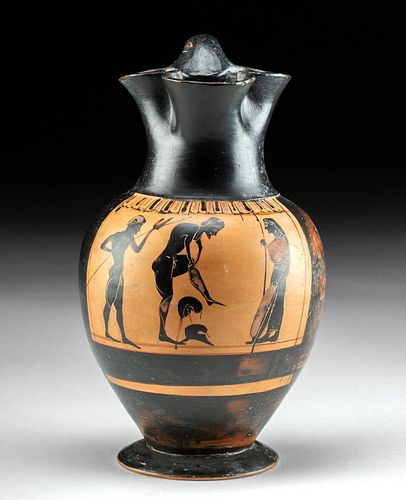Attic Black-Figure Oinochoe w/ Achilles, ex-Christie's
About Seller
686 S Taylor Ave, Ste 106
Louisville, CO 80027
United States
Selling antiquities, ancient and ethnographic art online since 1993, Artemis Gallery specializes in Classical Antiquities (Egyptian, Greek, Roman, Near Eastern), Asian, Pre-Columbian, African / Tribal / Oceanographic art. Our extensive inventory includes pottery, stone, metal, wood, glass and textil...Read more
Two ways to bid:
- Leave a max absentee bid and the platform will bid on your behalf up to your maximum bid during the live auction.
- Bid live during the auction and your bids will be submitted real-time to the auctioneer.
Bid Increments
| Price | Bid Increment |
|---|---|
| $0 | $25 |
| $300 | $50 |
| $1,000 | $100 |
| $2,000 | $250 |
| $5,000 | $500 |
| $10,000 | $1,000 |
| $20,000 | $2,500 |
| $50,000 | $5,000 |
| $100,000 | $10,000 |
| $200,000 | $20,000 |
About Auction
Nov 10, 2022
Museum-worthy examples of classical antiquities (Egyptian, Greek, Roman, Near Eastern), Viking, Far East / Asian, Pre-Columbian, African / Tribal, Oceanic, Native American, Spanish Colonial, Nautical, Fossils, Ancient Jewelry, Fine / Visual Arts, so much more! Artemis Gallery info@artemisgallery.com
- Lot Description
Ancient Greece, Athens (Attic), ca. 530 BCE. Finely decorated via the black-figure technique with incised and added fugitive red painted details, a beautiful trefoil oinochoe featuring the scene of a warrior - perhaps Achilles - readying himself for battle; the nude figure bending over to put on his greaves as a high-crested Corinthian helmet rests at his feet and a draped woman, possibly Achille's mother Thetis, and a young man stand to either side. Greaves and ankle guards were hammered from sheet bronze and retained considerable tensile strength, allowing them to be snapped onto the raised leg, as seen here. The woman watches while holding the warrior's spear and shield, serving as an attendant. Behind him, the nude youth holds another spear, likely waiting to arm himself as well. A band of tongues decorates the area above, just below the trefoil spout of the vessel. Though the warrior's armor indicates he may be a hoplite, this may also be a representation of the arming of Achilles by his mother Thetis. Size: 4.2" Diameter x 7.4" H (10.7 cm x 18.8 cm)
According to Homer's Iliad, during the last year of the Trojan war, Patroclus, Achilles’s beloved friend, dons Achilles' armor in order to scare the Trojans back from the beaches of Greece. He succeeds in doing so but is killed by Hector and stripped of the armor in the process, leaving Achilles grief-stricken and armorless. Thetis comes to comfort her son and, after seeing his deep despair, persuades Hephaestus, the god of blacksmiths and craftsmen, to forge him new armor. The god accepts and makes a shield, a breastplate, a helmet, and greaves, which Thetis delivers to Achilles, as seen in this example. Enraged, Achilles then returns to battle with the sole aim of avenging Patroclus’ death by killing Hector, despite a warning that doing so would cost him his life. After defeating Hector, Achilles drags his corpse by the heels behind his chariot.
Athens mandated that all 18- to 20-year-olds participate in military service; however, during times of war, all male citizens through the age of 60 could be asked to serve. Hoplites carried a large, round, bronze-faced shield known as a hoplon in one hand, as seen in this example, and, in the other, an eight-foot-long wooden spear with a leaf-shaped iron head and a bronze butt spike. The butt spike was known as a sauroter, a "lizard killer," and, if the spear was broken, could be used as a weapon on the remaining end. It could also be used to stand the spear in soft ground or as a digging tool.
Scenes of warriors preparing for battle were quite popular in Ancient Greece and can be found on vessels in the Metropolitan Museum of Art (06.1021.164a, b), the Fitzwilliam Museum at Cambridge University (GR.6.1917), the Louvre (E813), Rijksmuseum van Oudheden (PC60), and the Athens Agora Museum (P24360).
Published: Christie's London (South Kensington), "Antiquities" (October 5, 2000), no. 195.; J. Eisenberg, "Art of the Ancient World, vol. XIII" (2002), no. 81; Ancient Arms, Armor (2004), no. 48; 1000 Years of Ancient Greek Vases II (2010), no. 72.
Provenance: ex-Royal Athena Galleries, New York City, New York, USA; ex-English collection; ex-Christie's South Kensington, London, United Kingdom, October 5th, 2000, sale 8724, lot 195
All items legal to buy/sell under U.S. Statute covering cultural patrimony Code 2600, CHAPTER 14, and are guaranteed to be as described or your money back.
A Certificate of Authenticity will accompany all winning bids.
We ship worldwide and handle all shipping in-house for your convenience.
#175405Possible minor repair to one of the lobes of the trefoil lip. Some areas of overpainting. Some minor nicks to rim and surface. Otherwise, excellent with great remaining detail and pigments.Condition
- Shipping Info
-
Artemis Gallery will no longer be able to offer in-house shipping for most international orders, as well as all oversized orders, including most paintings. These items are clearly marked in the listing as “3rd Party Shipping Required” in the listing. We have a list of recommended third party shippers to assist you in shipping to and from, and would be happy to assist you in working with them. We require a written authorization from the client to release property to any third party. You may fax a Shipping Release Form to 303-828-3235 or email your authorization to kristen@artemisgallery.com. Please note the all property must be removed from our premises within seven (7) business days following the last day of the auction.
-
- Buyer's Premium



 EUR
EUR CAD
CAD AUD
AUD GBP
GBP MXN
MXN HKD
HKD CNY
CNY MYR
MYR SEK
SEK SGD
SGD CHF
CHF THB
THB














